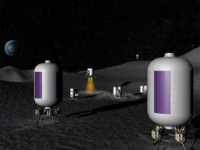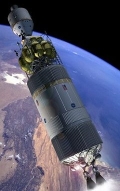Out of the cornucopia just in time for Thanksgiving . . .

Maize: Gift from America’s First Peoples
Columbus did not realize that the gift of maize was far more valuable than the spices or gold he hoped to find. He had no way of knowing that the history of maize traced back some 8,000 years or that it represented the most remarkable plant breeding accomplishment of all time. He might have been embarrassed if he had understood that then, as now, this plant developed by peoples he judged poor and uncivilized far outstripped in productivity any of the cereals bred by Old World farmers –wheat, rice, sorghum, barley, and rye. Were he alive today, he would certainly be astonished to see the extent to which the advent of maize has affected land use, food production, cuisine, and population growth around the world.
Walton Galinat, 1992, “Chilliesto Chocolate”
Source: Iowa State University Maize Page

 Artist rendition of the “rocket chair,” designed to lower people and equipment onto the lunar surface. credit: Spacedev
Artist rendition of the “rocket chair,” designed to lower people and equipment onto the lunar surface. credit: Spacedev The W32/Sdbot-ADD worm infecting some users of AOL Instant Messenger is more dangerous than previously thought, according to Facetime Security Labs, the researchers who discovered the worm in October.
The W32/Sdbot-ADD worm infecting some users of AOL Instant Messenger is more dangerous than previously thought, according to Facetime Security Labs, the researchers who discovered the worm in October. Unfortunately, the radiation that pervades space can trigger such glitches. When high-speed particles, such as cosmic rays, collide with the microscopic circuitry of computer chips, they can cause chips to make errors. If those errors send the spacecraft flying off in the wrong direction or disrupt the life-support system, it could be bad news.
Unfortunately, the radiation that pervades space can trigger such glitches. When high-speed particles, such as cosmic rays, collide with the microscopic circuitry of computer chips, they can cause chips to make errors. If those errors send the spacecraft flying off in the wrong direction or disrupt the life-support system, it could be bad news.